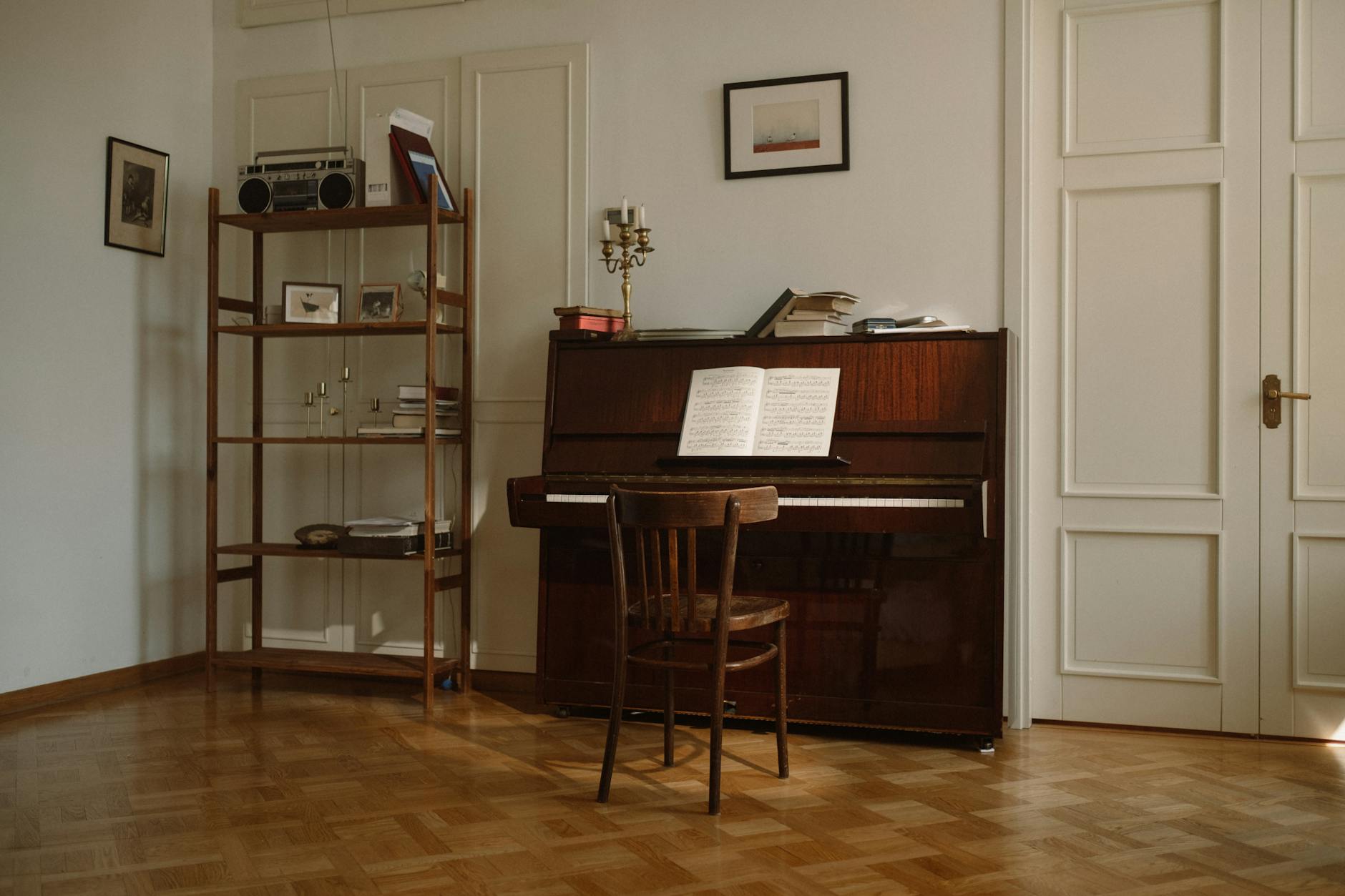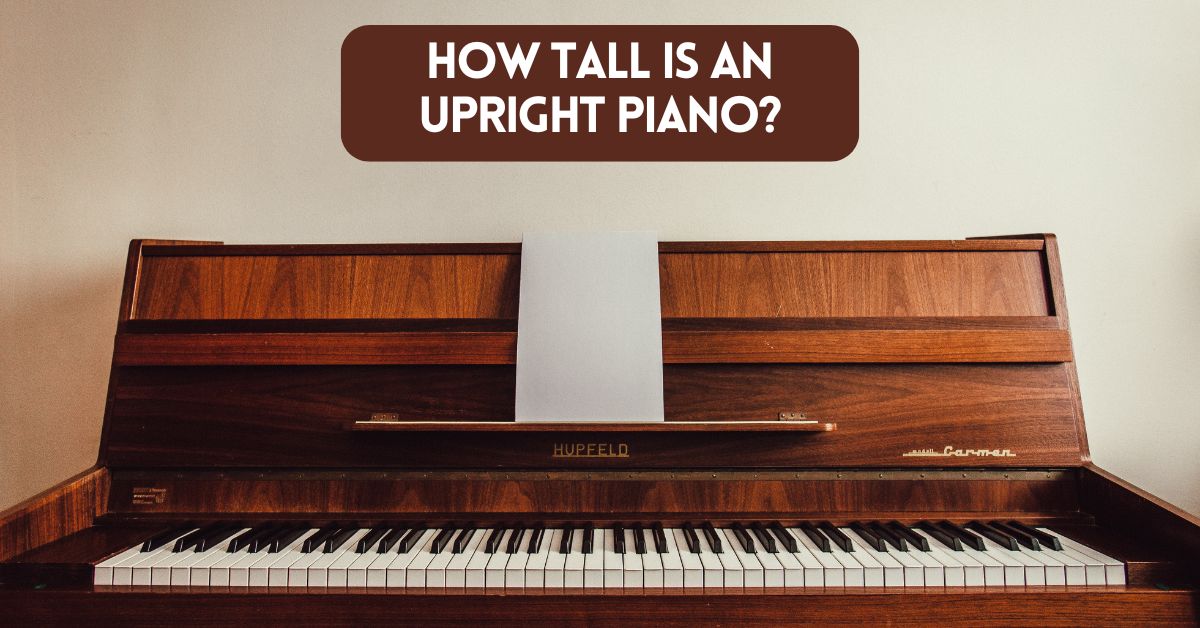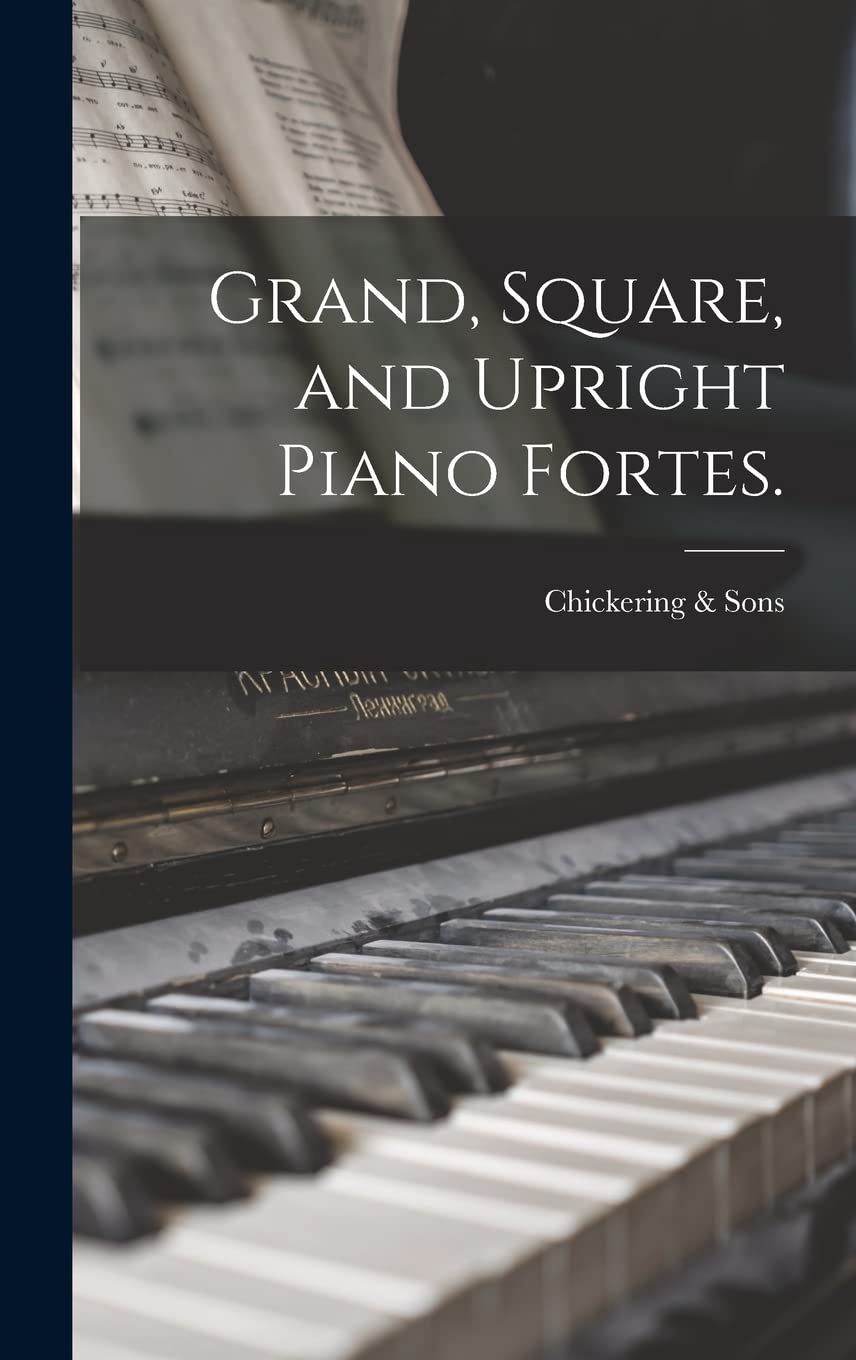Upright pianos, with their space-efficient design and traditional charm, are a popular choice for homes, schools, and studios. Understanding their sizes and features is crucial when choosing the right model for your needs. In this blog post, we answer the question, “How tall is an upright piano?” We’ll also explore the different types of upright pianos, their dimensions, and key features to help you make an informed decision.
Azure Hills Music contains affiliate links and is a member of the Amazon Services LLC Associates Program. As an Amazon Associate, we earn from qualifying purchases at no extra cost to you when you purchase using one of these Amazon links. Read our disclaimer and privacy policy for more information.

Introduction to Upright Pianos
Upright pianos are a fascinating aspect of piano design, offering a wonderful blend of aesthetic appeal and practical functionality. Known for their vertical structure, these pianos are distinguished by their ability to fit comfortably into smaller spaces, making them a preferred choice in homes and studios where space is a premium. With various heights and different sizes available, upright pianos provide a range of options to suit diverse musical preferences and stylistic demands. From smaller pianos that cater to limited spaces to larger models that produce a fuller sound, understanding the different piano types is essential for anyone looking to find the perfect upright piano to match their environment and musical ambitions.
Common Upright Piano Sizes
Upright pianos typically range in height from 36 inches to 60 inches. Their height is the primary distinguishing factor among the various subcategories, while their width (approximately 58 inches) and depth (usually between 22 and 26 inches) remain fairly consistent. Below, we’ll dive into the features of the main types of upright pianos: spinet, console, studio, and standard upright.
Spinet Piano Features
Spinet pianos represent the shortest upright piano model, standing between 36 and 39 inches tall. The compact size of these smaller pianos makes them ideal for small spaces such as apartments or studios. Key features include:
- Drop-action mechanism: Spinet pianos use a drop-action mechanism that allows the keys to be more compact, although it may sacrifice some responsiveness.
- Lightweight design: Easier to move and transport compared to larger pianos.
- Aesthetic appeal: Often chosen for their elegant design that complements home decor.
However, the smaller size and drop-action mechanism may result in a less dynamic sound and limited volume compared to larger upright models.
Console Piano Features
Console pianos are slightly larger than spinets, with a height ranging from 40 to 44 inches. They strike a balance between size and sound quality. Key features include:
- Direct-blow action: A more responsive key action compared to the drop-action mechanism in spinets.
- Improved sound: Larger soundboard and strings offer richer tones.
- Decorative designs: Often available in various finishes and cabinet styles to suit different aesthetics.
Console pianos are a popular choice for beginner and intermediate pianists due to their sound quality and reasonable price point.
The piano action of a console piano is known as a direct-blow action. This type of action mechanism is generally more responsive than the drop-action mechanism found in smaller spinet pianos. In a console piano, the hammers strike the strings directly when a key is pressed, which allows for greater precision and a more immediate response, enhancing the player’s control over dynamics and articulation.
When comparing the action of a console piano to that of a full upright piano, it’s important to note that full uprights typically have even larger action assemblies, which can facilitate a heavier touch and more robust sound. Full uprights might offer a wider dynamic range and more nuanced tonal expression due to their increased size, which allows for longer strings and a larger soundboard. However, console pianos still provide a satisfying playing experience and are often favored for their blend of compact size, affordability, and improved sound quality over smaller models.
Studio Piano Features
Studio pianos, commonly found in music schools and practice rooms, range from 45 to 48 inches in height. They are designed with durability and sound quality in mind. Key features include:
- Full-sized soundboard: Larger soundboard and longer strings provide better resonance and tonal depth.
- Sturdy construction: Built for heavy use, often featuring reinforced frames and durable materials.
- Professional tone: Suitable for serious students and performers.
Studio pianos offer a professional-grade experience while remaining more compact than grand pianos.
Standard Upright Piano Features
Standard upright pianos, also known as professional or full-size uprights, are the tallest among upright pianos, standing between 48 and 60 inches tall. Key features include:
- Grand piano-like tone: Their height allows for longer strings and a larger soundboard, resulting in a rich, resonant sound.
- Robust build: Designed to last for decades with proper maintenance.
- Classic appearance: Often chosen for their traditional look and commanding presence.
Full upright pianos are ideal for experienced players seeking the tonal quality of a grand piano in a more space-efficient design.
Upright Piano Height
While standard upright pianos may seem imposing due to their tall height, they offer many benefits for different types of pianists. The average height of a standard upright piano is around 52 inches, making it taller than console and studio pianos but shorter than grand pianos. These tall pianos make a great option for intermediate to advanced players who want a professional-grade sound without sacrificing too much space in their home or studio.
The tall height of standard upright pianos also allows for longer strings and a larger soundboard, resulting in a rich, resonant tone similar to that of a grand piano. This benefits experienced players looking for an instrument with a full and dynamic sound. Additionally, the sturdy build of these pianos can withstand heavy use, making them suitable for professional performers.
Furthermore, the classic appearance of standard upright pianos adds to their appeal and makes them a popular choice for those seeking a traditional aesthetic. Due to their commanding presence, they can also serve as a statement piece in any room.
If you are looking for a less tall piano, your options include spinet and console models. However, while these pianos take up less vertical space, you’ll also sacrifice playability in the smallest upright piano models.
Upright Piano Width
The standard width of an upright piano is approximately 5 feet, making it a compact yet powerful instrument. The standard 60 inch width allows the pianos to fit through doorways fairly easily. This size allows for easy placement in smaller spaces, such as apartments or practice rooms, without sacrificing the quality and sound of a larger grand piano. In fact, many modern upright pianos have been designed with space-saving features in mind, such as slim profiles. This makes them a practical option for those with limited space but still want the versatility and range of a full-sized piano.
Upright Piano String Length
One of the defining features of a standard upright piano is its longer string length compared to smaller upright pianos such as spinets and consoles. This results in a fuller and richer sound, making it more suitable for experienced players. The longer strings also allow for a wider range of notes, providing more versatility in playing styles.
Compared to grand pianos, the length of the strings in standard uprights may be shorter, but this does not diminish their overall quality. In fact, some advanced upright models even have string lengths comparable to those of smaller grand pianos. This highlights the importance of considering a piano’s specific specifications rather than solely relying on its size or type.
The string length plays a crucial role in producing the desired tone and resonance in a piano. A longer string length means more vibrations and harmonics, resulting in a fuller, warmer sound. This is why professional musicians often prefer grand pianos for their superior sound quality.
Who is an Upright Piano Recommended For?
Upright pianos are recommended for many individuals, from beginner pianists to professional musicians. However, the type and size of upright piano best suited for each individual may vary.
Smaller upright pianos such as spinets or consoles may be a more practical choice for beginners or those with limited space. These models offer compact designs and lighter weight, making them easier to fit into smaller spaces and move around when needed. Additionally, their lower price point can make them a more affordable option for those on a budget.
On the other hand, for experienced players who prioritize sound quality and have the floor space to accommodate it, larger standard uprights or even grand pianos may be a better choice. These models offer a more robust and dynamic sound, closer to that of a grand piano, making them ideal for performances or more advanced practice.
Ultimately, the size and type of upright piano recommended for an individual will depend on their specific needs and preferences. It is important to consider both the available floor space and desired sound quality when making a decision.
Upright pianos are versatile and cater to a wide range of users:
- Beginners: Spinets and consoles are great for new learners due to their affordability and manageable size.
- Intermediate players: Console and studio pianos provide enhanced sound quality and key responsiveness.
- Professionals: Standard upright pianos offer the tone and build quality required for advanced performances.
- Space-conscious buyers: Upright pianos are ideal for those who want a quality instrument without the space requirements of a grand piano.
Are Upright Pianos Good?
Yes, upright pianos are an excellent choice for many musicians. They provide:
- Affordability: Uprights are more budget-friendly than grand pianos.
- Compactness: Ideal for smaller spaces while still offering high-quality sound.
- Durability: Built to last with proper care and maintenance.
- Versatility: Suitable for a wide range of skill levels and musical styles.
While they may not offer the same tonal depth as a grand piano, upright pianos are a reliable and practical option for most pianists.
Main Differences – Upright Piano vs. Concert Grand
One of the main differences between upright pianos and concert grand pianos is their size. Concert grand pianos are much larger, with an average length of 9 feet, compared to the maximum height of 60 inches for upright pianos.
Another significant difference is in their sound quality. Concert grand pianos have a more powerful and resonant sound due to their larger size and longer piano strings. They also have a wider range of dynamics and tonal colors.
Upright pianos, on the other hand, may have a smaller range of dynamics and tones due to their compact design and shorter strings. However, advancements in technology have led to improved sound quality in upright pianos, making them a close second to grand pianos in terms of sound.
In terms of cost, concert grand pianos are significantly more expensive than upright pianos. This is due to their larger size and higher quality materials used in construction.
Lastly, while both types of pianos share similar mechanisms for playing, the action (or responsiveness) may differ. Concert grand pianos often have a more responsive key action compared to uprights, allowing for greater control and expression while playing.
Dynamic Range Differences
The dynamic range of a piano refers to the range of volume and intensity that can be produced by the instrument. In general, grand pianos have a wider dynamic range compared to upright pianos due to their larger size and longer strings. This allows for a greater variety in tone and expression while playing.
However, with advancements in technology and improved design, many modern upright pianos now offer a close second in terms of dynamic range compared to grand pianos. While there may still be some differences between the two types of pianos, both offer a wide enough range for most musical needs.
Upright Pianos Compared to Digital Pianos
While both upright pianos and digital pianos have their unique features and benefits, there are some distinct differences between the two that may influence a person’s decision to choose one over the other.
One of the main differences is in their sound production. Upright pianos produce sound acoustically through vibrating strings and hammers, while digital pianos generate sound electronically through speakers. This results in a different overall tone quality, with acoustic pianos having a warmer and more dynamic sound than electric pianos’ digitally produced sound.
Another significant difference is in touch sensitivity. Acoustic upright pianos have weighted keys that offer a more realistic feel than digital pianos’ lighter plastic keys. This can greatly impact the playing experience and technique for more advanced musicians.
Upright pianos also have a longer lifespan than digital pianos, as they are made from durable materials and can be maintained and repaired over time. Digital pianos, on the other hand, may require frequent updates or part replacement as technology advances.
Regarding cost, upright pianos tend to be more expensive than digital pianos. However, this is because they use higher-quality materials and construction, which contributes to their long-term value.
Regarding personal preference, some people may prefer the traditional sound and feel of an acoustic piano. In contrast, others enjoy a digital piano’s modern features and convenience. Overall, upright pianos are preferred for those looking for a more traditional and authentic playing experience with higher sound quality and durability. However, digital pianos can be a practical choice for those who value portability and versatility in sound options. Both types of pianos have their own strengths and benefits, making them suitable choices for different musicians in different situations.
Price Range of Upright Pianos
Upright pianos offer a diverse price range, accommodating different budgets and preferences. In the used market, prices can vary significantly based on the piano’s age, brand, condition, and any necessary repairs or tuning. You might find a used upright piano for as low as $500 to $1,000, though more reputable brands or well-maintained instruments can fetch upwards of $3,000 or more. You’ll likely be able to find a good selection of such old pianos in most markets.
For new upright pianos, the starting price for entry-level models is typically around $3,000 to $5,000. Reputable manufacturers often produce these pianos and are suitable for beginners or those seeking a reliable instrument. Mid-range new upright pianos tend to range from $5,000 to $10,000, offering enhanced sound quality, better materials, and craftsmanship. High-end models, which can exceed $10,000, are crafted with the finest materials, offering superior acoustics and aesthetics, often chosen by professional musicians or serious amateurs seeking a long-term investment.
Learn More About Upright Pianos
Read “Grand, Square and Upright Piano Fortes” from Chickering and Sons.
FAQs
Q: How much space does an upright piano need?A: Most upright pianos require a space approximately 5 feet wide and 2 feet deep. Ensure additional clearance for the bench and player.
Q: How often should I tune an upright piano?A: Upright pianos should be tuned at least once or twice a year, depending on usage and environmental factors.
Q: Can an upright piano be moved easily?A: While smaller models like spinets are easier to move, all upright pianos require careful handling to prevent damage.
Q: Do upright pianos have pedals?A: Yes, most upright pianos have three pedals: soft, sostenuto, and sustain.
Q: How long do upright pianos last?A: With proper care, an upright piano can last 40 to 50 years or more.
Conclusion
Upright pianos come in various sizes and designs to suit different needs and preferences. Whether you’re a beginner looking for a compact spinet or a seasoned pianist seeking the robust sound of a standard upright, there’s an option for everyone. Upright pianos are a popular choice of many people and they are a reasonable consideration for beginners through advanced players. Their combination of affordability, quality, and space efficiency makes upright pianos a timeless choice for musicians around the world.


